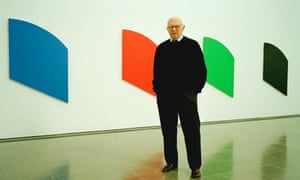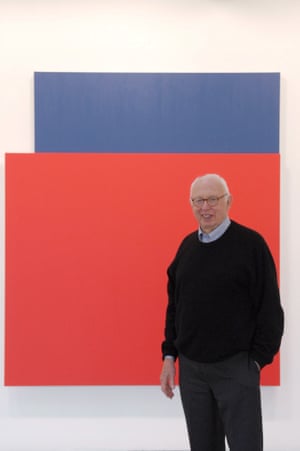Ellsworth Kelly in a free exhibition at Tate Liverpool: http://ow.ly/J4rR30aYUhP
Ellsworth Kelly, Méditerranée 1952 © Ellsworth Kelly

Ellsworth Kelly
Painter
Ellsworth Kelly is an American painter, sculptor, and printmaker associated with hard-edge painting, Color Field painting and the minimalist school. Wikipedia
Born: May 31, 1923 (age 92), Newburgh, New York, United States
Artist Ellsworth Kelly, Master Of Colorful Abstraction, Dies At 92
Kelly was recognized as one of the greatest American artists of the 20th…
NPR.ORG|由 MORNING EDITION 上傳
MoMA The Museum of Modern Art
Ellsworth Kelly changed the face of art. At 92, he's still not done
American painter’s intense, humming hues were groundbreaking and he’s building on his experiments in Paris in the 1950s

The colours are always brilliant in Ellsworth Kelly’s world – even in the garden. Two hours north of New York, outside a studio built to his own design, is a lawn of such intense and blazing green it could be one of the American painter’s own monochromes. For more than 50 years, Kelly has been creating even, saturated paintings and reliefs whose forceful hues – deep red, soft blue, thrumming yellow – remain burned on the retina long after you leave the white cube. Few artists alive today have done so much to rethink the possibilities of painting. Even fewer have offered viewers such endless joy while doing so.
Kelly is now 92. If you exclude his recourse to an oxygen tank to help him breathe – decades in the studio inhaling turpentine fumes have done a number on his lungs – he is as spry, as sharp, and as hard-working as artists a third of his age. Most days he is in his studio, sometimes painting, sometimes planning an upcoming show at the soon-to-reopen San Francisco Museum of Modern Art. He and his partner Jack Shear, a photographer who also directs Kelly’s foundation, show me a few recent purchases. There’s an exquisite little Braque, for one; there’s also a number of south-east Asian lingams, fertility stones lined up like soldiers.
Kelly sits down and opens the first of six planned volumes documenting his complete paintings, reliefs and sculptures. The catalogue raisonné (an art historian’s bible, detailing each work’s provenance, exhibition history, and scholarly apparatus) is being published by the French publishing house Cahiers d’Art and has been edited by Yve-Alain Bois, an authority on abstract painting at Princeton’s Institute for Advanced Study. This first volume concentrates on his six years in Paris, from 1948 to 1953. It makes a strong case that Kelly’s Paris years set the stage for his entire career – and for much of American art to come.
Kelly was born in 1923, in upstate New York, and after studying at the Pratt Art Institute in Brooklyn he enlisted in the army – joining the 603rd Engineers camouflage battalion, a specialist unit of artists and architects who crafted decoys. After being honorably discharged, he qualified for the GI bill and enrolled at the school of Boston’s Museum of Fine Arts. The life drawing classes helped him, he says, but the approach to modern art did not. “One day in ’46 or ’47, I went down to see a secretary about something, down in the basement of the museum. There was a painting behind her. I said, ‘Is that a Braque?’ And she said yes. I couldn’t believe it. ‘Why isn’t it upstairs?’ She said, ‘Well, they didn’t like it.’”

Many of his earliest works were proficient, if safe, portraits of himself and his friends – such as a suggestive painting of a young man in the bath, its forms indebted to Gauguin. The gent in the tub was a fellow artist. “We used to hitchhike down from Boston to New York, to go to the Modern [ie the Museum of Modern Art] all the time. So I wasn’t not educated about the School of France. And I’d been in Paris a bit during the war, but then all the museums and galleries were closed. My dream was to go back. And as soon as I could, I did.”
“Picasso said, ‘Do I know you?’ And his chauffeur came back; he was inviting me to come in and sit. I thought, my French was so bad if I get in he’ll kick me out in three minutes.” Picasso sped off. Under the terms of his army scholarship, Kelly was supposed to attend the École Nationale Supérieure des Beaux-Arts. He enrolled, but the art school never took attendance, and so instead of taking classes he explored the collections of the Louvre and the Musée Guimet, paid calls to Fernand Léger’s studio, and visiting Romanesque churches in the French countryside. The young American painted increasingly abstract nudes, heavily indebted to Pablo Picasso. “I thought he showed young artists how to make a picture. I liked him from the beginning – but I felt that I had to get him off my back. I only saw him once. He was in a car, backed up in traffic, and I looked into the window and there he was with his black eyes” – and he holds the final word, as if the master’s intense gaze were still upon him.
In the summer of 1949 Kelly left Paris for an austere cabin on an island off the coast of Brittany, where his art turned sparer and more abstract. Instead of distinguishing foreground and background, now he was painting forms as solid blocks of colour against an equally flat expanse of white. A window, for instance, is simply a vertical stripe crossed with three bars. They were so radical, I say; how did people react? “I didn’t show anyone. The only one I did show, who was interested, was Agnes” – his fellow painter Agnes Martin, that is. “Agnes was very interested. I think in a way – Jack seems to think that too – that I gave Agnes the idea of the grid.”
Kelly had his breakthrough: by transferring an object or a scene from the real world into only its most basic outlines, he could evade the influence of Picasso and paint only for himself. He compounded that breakthrough in one of his greatest paintings, Seine, completed in 1951 and now in the collection of the Philadelphia Museum of Art. “I lived on the Île Saint-Louis. Every night, walking home, I would walk down the outside quay and see the lights from the bridges on the water. I would just stand there and look at those reflections, and I thought: I want to do something that looks like this. But I don’t want to do a Pointillist painting. I said, I want to do something that flickers.

“So I wrote down 40 numbers and I put them in the box, one through 40.” He pulled out a single number – it must have been 21 – and painted a single rectangle halfway down the left side of the canvas. “Then I picked out two numbers, then three, four, five, six, until I got to the black in the center. Then when I got halfway I started reversing it.” The result: an ahead-of-its-time digital rendering of the river, made long before television and computer screens taught us to break images into pixels. As Bois astutely observes, Seine’s combined use of chance and of a gridded system of composition was unprecedented in painting, and parallels the randomly generated musical works of Pierre Boulez more than the art of any of Kelly’s coevals.
“When I came back, I thought I had arrived at some point. That I had done things that were important to me. And I think I knew what I had done, and that I didn’t have any French painter, or American painter in Paris, that I owed anything to.” But Kelly had missed the entire development of abstract expressionism while he was away. New York was Jackson Pollock and Willem de Kooning’s town in those days. Critics and curators were stumped by Kelly, whom they badly misdiagnosed as aMondrian follower. Not until the 1960s, with the rise of pop and minimalism, did Kelly’s bold colour and immaculate form win the attention it deserved.The black-and-white Seine gave way to intense, joyous colour in 1952 and 1953: rectangles of red, blue and yellow, or else a whole spectrum of bright stripes. And maybe he never would have left Paris – he’d stayed in France long after his GI funding dried up. But in November of 1953 his landlord turfed him out of his studio in favour of a higher-paying tenant. (Ellsworth Kelly: an early victim of Parisian gentrification.) He fell ill too. New York beckoned.
Sixty years on from his Paris days, he is still at it. Earlier this year, at Matthew Marks Gallery in New York, he stunned again with audacious reliefs in the form of backward letter B’s, and in his studio he shows me an thrilling unexhibited work, with jostling expanses of green, purple and black. In leafy Spencertown he seems to have the perfect setup – a light-filled studio, ample exhibition space, the stillness of the country. But does he ever miss the bustle of Paris?
He pauses. Then: “It was wonderful. It was the best time of my life, I guess.” And he smiles the smile of a man whose youthful expedition changed painting for good.
Today we remember Ellsworth Kelly (1923-2015), with a few thoughts from Harry Cooper, curator and head of modern art:
"Ellsworth Kelly was one of our great visualists, to use the word that he liked to apply to himself. He showed us that a simple problem—the interaction of a single color and a relatively simple shape—was not so simple after all. Looking at a Kelly painting for a few minutes, really looking, is an exercise that can and should change the way we see everything else."
Learn more about Kelly and this work of art:http://bit.ly/EllsworthKellyTiger
Ellsworth Kelly (1923-2015), "Tiger," 1953, oil on canvas (five joined panels), National Gallery of Art, Washington, Gift of the Artist



沒有留言:
張貼留言